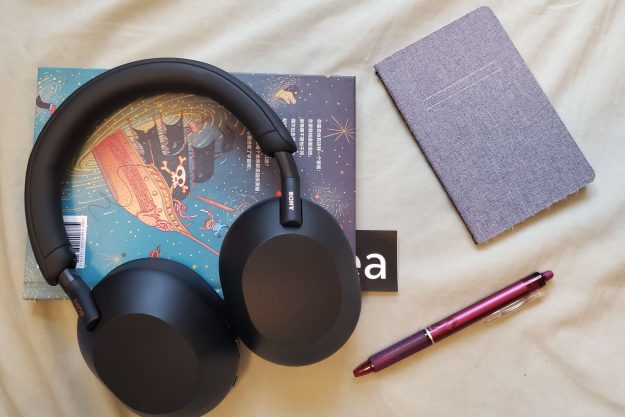
“The new u-Jays blend wireless connection with great sound and timeless style for a killer triple cocktail.”
- Clear sound signature with excellent stereo imaging
- Simple, elegant design
- Intuitive and lockable touch controls
- Great battery life
- Headband could be more comfortable
- No included case
After Beats took the headphone market by storm a few years back, it became more difficult to find a simple, elegant looking set of headphones that didn’t feel exclusively designed as a competitor to Dr. Dre’s burgeoning empire. Yet, while many brands looked to mimic Beats’ flare for flashy style and bombastic bass, Swedish headphone maker Jays went the other way.
A sleek, minimalist pair of on-ear headphones without a single exposed hinge or wire, the company’s original u-Jays impressed thanks to extremely clear sound and classic style at an affordable price. So how does the newly minted wireless version of the u-Jays hold up? While they offer nearly identical looks and sound performance as their wired counterpart, the addition of intuitive touch controls, great battery life, and a 20 percent price drop make the u-Jays’ second take more compelling than ever.
Out of the box
The u-Jays Wireless come in a very similar package to their wired predecessor, laid flat in molded foam inside a thin black box. Branding is Scandinavian minimalism to the core, with wide swaths of solid black accented by light streaks of gold. Accessories in the box include a 3.5 mm cable, a micro USB charging cable, and instruction materials.
It’s worth noting that, though the wired u-Jays came with a drawstring bag, the wireless iteration doesn’t. Also, the u-Jays Wireless’ included audio cable doesn’t come with the same three button iOS controls we saw on the wired version, but that’s because the added touch controls replicate the same functionality — more on that later.
Features and design
The effortlessly simple design we loved about the wired u-Jays is back in virtually identical form for the u-Jays Wireless. That goes for all our favorite hallmarks, including the stylish rubberized headband, the easy-swivel earpieces, and the perfectly rounded earpads layered in supple leather. While we love theall-black option, if that’s too understated for your taste, the u-Jays also come in black and gold, white and gold, and white and silver colorways.
The u-Jays Wireless accurately reproduce every style of music you throw at them.
The only real physical change between the two versions that isn’t explicitly for wireless functionality (the company added a charging port and power button on the back of the right earcup), is that the lower part of the headband that denotes the stereo sides has been painted on rather than molded in raised plastic.
In keeping with their similar design, comfort remains almost identical between the wired and wireless versions of the u-Jays — in general, the headphones have just enough padding to get the job done. That said, the added weight from the batteries does mean that the semi-padded headband is slightly more bothersome than it was on the wired version. After a few hours of listening, you may need to give your head a break.
The u-Jays Wireless hide their coolest new feature in plain sight, in the form of an invisible touch pad for playback control. As we’ve seen with many other
While the touchpad feature is commonplace these days, Jays is one of the few companies to offer a lock for its touch controls, to limit unwanted commands when you adjust them on your head or accidentally touch them. It may seem simple, but it’s an extremely welcome feature that’s also very easy to engage: Simply press the power button twice to enable or disable the lock, at which point a helpful beep will let you know your settings have been changed.
In keeping with the overall theme of usability, the headphones also auto-detect when you plug in the audio cable, disabling all powered functions to save you juice. Battery life is rated at a respectable 25 hours, and in practice we were able to get multiple days of use out of the
It’s also worth noting that Jays lowered its overall price points. While the original headphones were priced at over $200, the wireless version is just $180 (while the wired model has dropped to $120). Where they were previously competing with better-sounding alternatives from companies like Thinksound, the u-Jays are now in a class all their own. The price drop also makes us a lot less concerned about the lack of a carrying case, which we expect as part and parcel with more expensive models.
Setup
Setting up the wireless u-Jays is quick and painless. Simply charge the headphones, then press and hold the power button. Once the white LED on the bottom of the right earphone starts blinking, locate the
Audio performance
The same 40mm dynamic drivers we heard in the wired u-Jays return in the wireless iteration, providing the same linear and dynamic sound we’ve come to know and like.
In keeping with the u-Jays other minimalist tendencies, everything in the sound profile feels simple, if slightly restrained. They don’t offer quite the same vibrant and energetic reproduction of instruments as headphones like Marshall’s slightly more expensive Mids, but they do make each instrument easy to pick out in a mix.
Like their wired predecessor, the u-Jays Wireless accurately reproduce every style of music you throw at them — no small feat for headphones in this segment.
The sleek, minimalist design we loved about the wired u-Jays is back in full form.
On songs like Kadhja Bonet’s Remember The Rain, there’s a pleasant string shimmer atop the groovy R&B drums and bass, while acoustic songs like Hiss Golden Messenger’s Lateness of Dancers showcase a pristine upper register in the vocals. Regardless of what genre or artist you listen to, each song sticks very closely to its source material, with very little coloration. While that may not be for everyone, we quite enjoy the hands-off approach to the sound signature, especially refreshing in a world which seems to demand massive bass response — even when the music doesn’t call for it.
Stereo imaging is perhaps the place where the u-Jays Wireless shine brightest. The headphones place the hand drums on Sinkane’s afro beat-influenced song Telephone on the outside of a very wide soundstage, where they are joined by trumpet and sax lines to create an extremely fun to listen to atmosphere.
Our Take
The new u-Jays Wireless keep everything we liked about the original, while dropping the price, and adding functionality to emerge as one of the better options in their category. What’s not to like?
Is there a better alternative?
There are a few other great Bluetooth-enabled headphones worth checking out at similar price points, including the excellent Marshall Mid on-ear and the Plantronics Backbeat Pro 2 over-ear, but even in the company of these fine choices, the u-Jays Wireless are no slouch.
How long will it last?
Solid construction and simple design — as well as the fact that the company hasn’t changed much from the previous model — leads us to believe that the u-Jays Wireless will last for years of regular use before they’ll need to be retired.
Should you buy it?
Yes. With great looks, functionality, and solid overall sound, the u-Jays Wireless are absolutely worth considering, especially if your favorite music isn’t dependent upon massive sub-bass rumble.
Editors' Recommendations
- Marshall’s latest headphones get 100 hours of battery life and wireless charging
- AirPods 4: Everything we know about Apple’s next wireless earbuds
- Samsung Music Frame hands-on: invisible audio done right
- Best wireless earbuds for 2024: Sony, Bose, Soundcore, and more
- The best wireless headphones for 2024 from Bose, Sony, 1More and more









